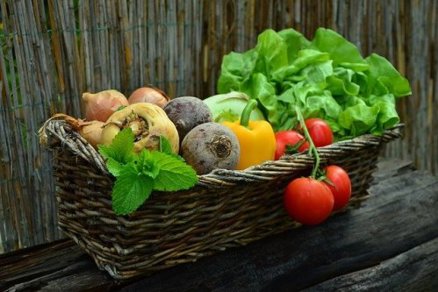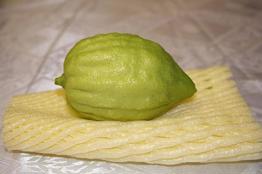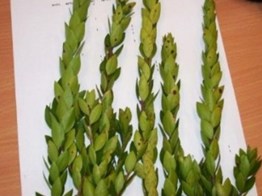Otzar Ha'aretz – the optimal way to observe the shemitah year

What produce is sold at Otzar Ha'aretz stores? How does the distribution system work and what are the special guidelines that apply to each link in the chain? Chapter 14 of the Consumer's Guide to Shemitah.
A. Introduction
This year, 5782 (2021–2022) just as in previous shemitah years, Torah VeHa'aretz Institute operates a program called Otzar Ha'aretz. Otzar Ha'aretz runs based on the laws governing otzar beit din (see Chapter 11, §B.1) in such a way that all of the intricate halachot relating to the manner of handling the produce, its sale, and consumption are observed in full under the supervision of the rabbinical court. Otzar Ha'aretz encourages Jewish, Torah-observant agriculture of all forms and believes that it is a tremendous privilege and hiddur to make an effort to eat the sacred fruit of the Land of Israel during the shemitah year.
B. Sources of fruits and vegetables sold through Otzar Ha'aretz
- Vegetables stored/refrigerated that belong to the sixth year (isum shishit).
- Vegetables and fruit that have shemitah sanctity (olei Bavel and olei Mitzrayim territory).
- Vegetables grown in hothouses on detached platforms.
- Vegetables grown in the Aravah,[1] sold through heter mechirah lechumrah (the strict interpretation of heter mechirah, based on Rabbi Kook's ruling; see the map in Appendix E). In these areas, planting and sowing are performed by non-Jews, some in open fields and some in regular hothouses (not on detached platforms).
- Vegetables grown in the olei Mitzrayim territory (Western Negev), including heter mechirah lechumrah (according to Rabbi Kook's ruling; see the map in Appendix E). In these areas, planting and sowing are performed by non-Jews, some in open fields and some in regular hothouses (not on detached platforms).
- Vegetables that are generally bought from non-Jews during non-shemitah years, when all other options are unavailable.
- Imports, when all other options are unavailable.
C. Produce with shemitah sanctity
- Vegetables planted during the sixth year and harvested during shemitah (in open fields in olei Bavel territory).
- Vegetables planted during the sixth year and harvested in hothouses in olei Bavel territory are handled as sacred [2]
- Vegetables planted in the sixth year in the Western Negev and Southern Aravah (olei Mitzrayim) in open fields or hothouses and harvested during This produce is handled as sacred lechumrah.[3]
- Fruit that began to form during the shemitah See Appendix A.
- Other fruits and vegetables (from the sixth year, detached platforms, vegetables planted during the shemitah year through heter mechirah in open fields or hothouses in olei Mitzrayim territory, fruit from heter mechirah orchards) that do not have shemitah[4]
D. Food supply chain: an overview
- Throughout all years, the food supply process includes the following components:
- Farmer
- Wholesaler
- Retailer
- Customer
- During the shemitah year, too, this chain is necessary for supplying food to the entire population. However, the regular mode of transaction cannot continue as usual due to the sanctity of the produce. Thus, the players involved need to follow the appropriate halachic guidelines, as detailed below.
E. Farmers
- The rabbinical court attempts to appoint Torah observant farmers or famers that might not be Torah observant in general, but are interesting in observing shemitah.
- Farmers sign a contract with the rabbinical court, stating that they are now the court's agents and that they commit to follow the guidelines of the rabbinical court. This also includes non-shemitah issues, such as Shabbat observance, kila'im, orlah, and terumot and ma'aserot.
- Farmers declare their fields ownerless through a notice they send to the rabbinical court.
- Farmers may perform all activities necessary to save plants or trees from dying (le'ukmei ilana), including acts necessary to tend to the fruits or vegetables (le'ukmei peira), but not activities that increase plant growth (avruyei ilana).
- Before the crops leave the farm, farmers mark their merchandise and note its halachic status.
- Farmers are paid according to an average of their expenses, as posted by the Ministry of Agriculture, plus a salary as agents of the rabbinical court, upon court directives. This amount is limited to the maximum rate posted by the Ministry of Agriculture and does not exceed it. The payment is made for actions that are performed from the moment of the signing of the contract with the rabbinical court.
- Detailed instructions regarding permitted and forbidden activities, as well as the contractual conditions between the farmer and rabbinical court, are provided directly to each farmer.
F. Wholesalers
Wholesalers are agents of the rabbinical court. Their job is to receive the merchandise from farmers and distribute it to storeowners. In addition, they receive the payment for the farmer's expenses from the court and transfer it to the farmers. Wholesalers receive crops only from farmers who contracted with the rabbinical court. Furthermore, they distribute all of the produce to the Otzar Ha'aretz grocery stores, including produce without shemitah sanctity.
G. Retailers
Retailers are the rabbinical court's agents who distribute the merchandise. They sign a contract with the rabbinical court to this effect. The price given to retailers is generally fixed for two weeks at a time and changes according to the rabbinical court's guidelines.
H. Produce
- An effort is made so that produce with shemitah sanctity need not be weighed. Rather, it is sold in packages with a predetermined weight (each package is marked with a barcode).
- The packages consists of bags with an estimated weight of 1 kg (up to 50 g more or less).
- Individual fruits or vegetables whose weight exceeds 1 kg (watermelon, cantaloupe, etc.) and produce generally purchased in small quantities (kohlrabi, etc.) are marked with barcodes and sold in units, not according to weight.
- Unsold sacred shemitah produce left over in the shops is set aside in a designated area in the store.
- Non-sacred produce is sold as usual (weighed, payment for the produce, etc.).
I. Supervision
- A supervision system is set up in the areas where crops are grown. All merchandise leaving these areas must be marked with kashrut certification.
- A supervision system is set up in the wholesale warehouses to check the marked merchandise received. It then prepares produce for each final destination, according to its needs.
- A supervision system is set up in the grocery stores (1) to prevent wares from begin mixed up and (2) to ensure that the prices set by the rabbinical court are used.
J. Payment
- Payment is meant to cover the expenses of the rabbinical court and its agents (farmers, wholesalers, and retailers).
- The rabbinical court has special expenses due to the shemitah year, including: actions performed twice (such as: early pruning or pruning in the summer and winter), and expenses for supervision in the field, packaging, marking produce, and transportation to supervised warehouses.
- That is, the overall cost of growing and supplying Otzar Ha'aretz fruits and vegetables is considerably higher than that of non-Otzar Ha'aretz
- For this reason, the price of the produce sold at Otzar Ha'aretz groceries is not considerably less expensive than the regular price of non-sacred fruits and vegetables in the marketplace (despite the fact that customers only reimburse the expenses of the rabbinical court and the rest of the food supply chain, and not the full price that includes profit for the farmer, wholesaler, and retailer). At times, the price will even be identical to regular produce. Note that often, due to the multiple, precise guidelines given by the rabbinical court regarding the permissible care for trees and fruit, and the fact that acts that result in enhancing plant growth (avruyei ilana) are forbidden, the quality of the sacred fruits and vegetables is somewhat inferior to regular produce.
- Payment for produce with shemitah sanctity is transferred to the rabbinical court, which uses it to pay the farmers, wholesalers, and retailers for their expenses.
- Members of Otzar Ha'aretz receive membership smartcards, which they use to purchase groceries with shemitah Non-sacred produce is bought as usual.
- Upon registration with Otzar Ha'aretz, members pay a fixed amount of money they estimate they will spend on groceries before the onset of shemitah year. Besides granting Otzar Ha'aretz membership, this sum becomes the members' debit account for sacred shemitah produce (divided into equal parts for each month; cards can be charged with additional sums as well).
Since this money is paid in advance, it is used to support farmers for growing produce on the public's behalf before the onset of the shemitah year, granting them peace of mind and financial security. Furthermore, it gives the rabbinical court an idea of the amount of expected buyers, helping it plan the desired quantity of produce to supply in the Otzar Ha'aretz grocery stores.
K. Flowers
Otzar Ha'aretz also sells flowers in bouquets one day a week. It also sells flowers directly to halls throughout the week.
L. Public Kitchens
Otzar Ha'aretz sells produce to several catering companies and educational institutions.
M. Website
Otzar Ha'aretz has a website that provides all of the important information for consumers including: the store distribution, prices, halachic responsa, halachic guidelines for using the sacred produce, and public inquiries. Members can also charge their membership card on the website. https://www.otzarharetz.co.il/shmita/
N. Halachic advantages of Otzar Ha'artez
- As mentioned above, the sales and distribution system for sacred shemitah produce is completely different from the standard sales and distribution system for non-shemitah The payment to famers is made against the expenses as posted by the Ministry of Agriculture, not according to market value.
- Merchandise distributed to consumers is conspicuously marked that it should be handled as sacred, so the produce's sanctity is emphasized.
- All agricultural activities performed during the process of crop cultivation, distribution, and sales are approved by the rabbinical court.
- The sale of all fruits and vegetables, even those without shemitah sanctity, places a major emphasis on Jewish agriculture, with only a minimal reliance on non-Jewishly grown crops. In this way, those who consume Otzar Ha'artez produce strengthen Jewish agriculture in the Land of Israel and enjoy eating sacred produce grown by Jews: "and let your brother live alongside you" (Vayikra 25:36).
[1] According to some posekim, part of the Aravah is outside of even the olei Mitzrayim territory (yet part of the territory promised to Avraham Avinu, gevulot ha'havtachah, which was never sanctified). For this reason, the laws governing this area are less strict than those in the Western Negev. See Chapter 11, n. 11.
[2] In regular hothouses, shemitah sanctity applies due to doubt. However, crops grown in hothouses on detached platforms are not sacred. See Chapter 3, §B.
[3] See Chapter 2, §A.3, that shemitah sanctity applies to olei Mitzrayim territory due to doubt. Despite the fact that in hothouses in the olei Mitzrayim areas there is a two-fold doubt, we nevertheless treat crops as sacred due to doubt.
[4] Otzar Ha'aretz does not sell heter mechirah produce for vegetables grown in olei Bavel areas during the shemitah year (in open areas or hothouses). Fruit is generally from olei Bavel territory through otzar beit din, not heter mechirah. Will Otzar Ha'aretz sell heter mechirah fruit from olei Mitzrayim, the Western Negev, or the Aravah areas? Last shemitah year, 5775, this wasn't a question, since there were few places that grew fruit in these areas (some citrus in Cholot Chalutzah, dates in the Aravah). Should this produce be relevant in shemitah of 5782, it will be a second option. For instance, we prefer bringing dates from the Jericho region, where there is shemitah sanctity, to dates from the Aravah.




